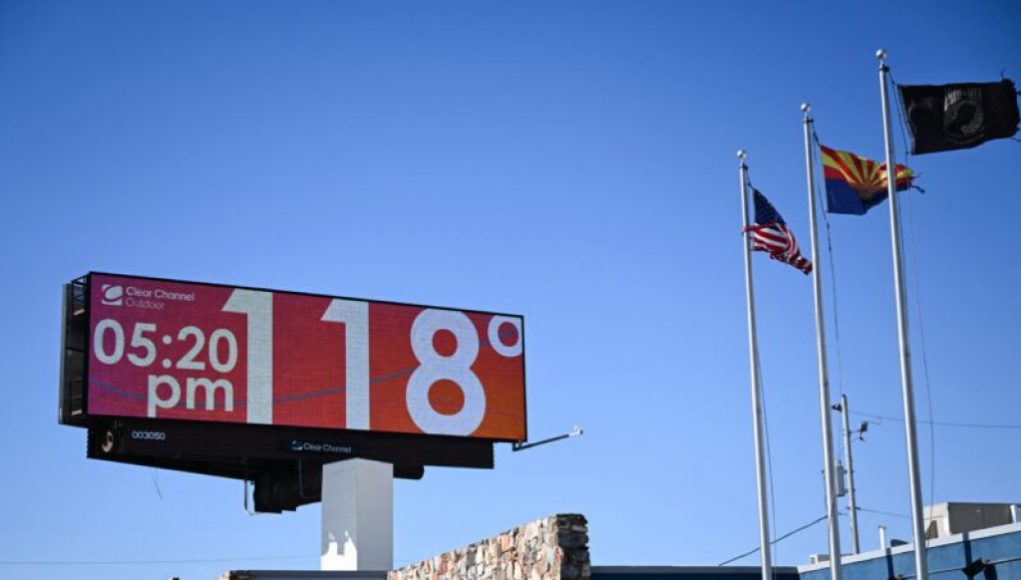Get ready for scorching summer heatwaves that will become the new norm unless we take immediate action to reduce greenhouse gas emissions, warn a team of international scientists. As temperatures soar above 110 degrees Fahrenheit across North America, Asia, and Europe, these extreme heatwaves will occur every two to five years if global warming reaches 2° Celsius above pre-fossil fuel levels. The researchers from World Weather Attribution conducted a rapid attribution analysis, revealing that the current climate, warmed by 1.1° C (1.9° F) due to human activities, has already made these heatwaves more frequent. In fact, they now occur approximately once every 15 years in North America, once every 10 years in southern Europe, and once every five years in China.
The analysis also found that greenhouse gas pollution intensified recent heatwaves. It made the European heatwave 2.5° Celsius (4.5° F) hotter, the North American heatwave 2° C (3.6° F) hotter, and the heatwave in China 1° C (1.8° F) hotter. Without global warming, the extreme heat experienced in North America and Europe would have been nearly impossible, while the heatwave in China was made 50 times more likely due to current levels of greenhouse gas pollution.
Advertisement
Co-author Friederike Otto, a climate scientist with the Grantham Institute at Imperial College, London, explained that the team tested the effect of global warming on various definitions of heatwaves, but the results remained consistent. The aim of their analysis is to understand the role of climate change during extreme weather events as they occur.
Over the past few years, a series of similar studies has highlighted the urgent need to address the impacts of climate change, which are already happening and will only worsen. Each study involves scientists from the affected regions, and while this particular analysis has not yet undergone peer review, previous studies by the team have been affirmed by scientific review panels.
“The role of climate change is absolutely overwhelming,” Otto emphasized. “It’s not surprising that these meteorological events are happening simultaneously. With our rapidly increasing emissions, we are witnessing the expected consequences unfold before our eyes.”
The world has seen high temperatures since the beginning of July, proving that climatologists were right to predict that this month would be hotter than usual. As of this week, Southern Australia is facing record-breaking temperatures that may eclipse the 2004 peak of 49.5 degrees Celsius.
While hot temperatures are common in summer months, this widespread heat has climatologists worried. Blistering heat like this is largely the result of climate change and is predicted to become more frequent due to rising temperatures worldwide. In fact, a study from the World Meteorological Organization found that the summer months in 2019 were the hottest on record.
Scientists in Australia are particularly worried about this heat wave, given that the country has experienced many extreme weather events in recent years. Bush fires have caused significant damage to parts of the continent since last summer, and this heat wave could exacerbate the issue.
Some experts believe that the extreme temperatures this month may actually be an underestimation of the reality of climate change. An Australian scientist suggests that this heat wave should be seen as a “warning sign” of how quickly global temperatures can rise as a result of human activities.
In the coming weeks, it is important for citizens to be mindful of their actions. Taking part in activities that are known to contribute to global warming can further accelerate the climate crisis. This means understanding and addressing one’s own footprint and developing sustainable strategies to reduce the impact of climate change.
The good news is that there is still time to act on climate change. Although July’s intense heat is a reminder of the havoc that climate change can wreak, it is also proof that climate action initiatives can have an effect if implemented properly. By making small changes and taking part in local politics, citizens can work together to make a difference.




















